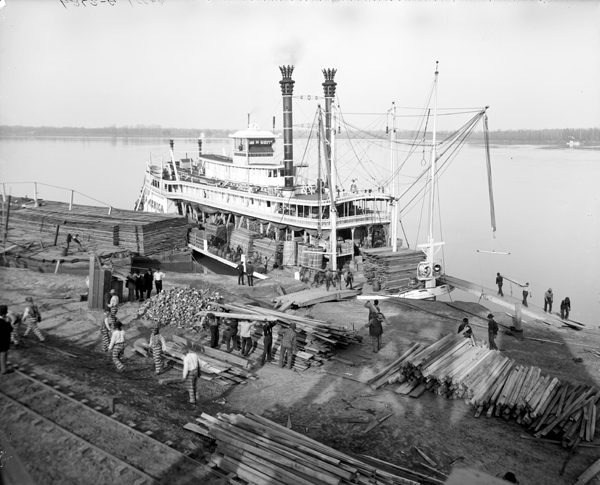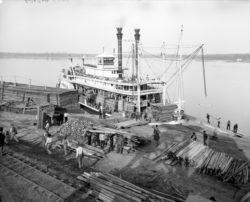Convict Leasing
Convict leasing was a system of penal labor instituted in the American South after the emancipation of slaves by the Thirteenth Amendment to the United States Constitution in 1865, involving the leasing out of prisoners to private companies.

Courtesy of Library of Congress Prints and Photographs Division.
This photograph, ca. 1900, depicts a docked ship and prison laborers at Angola, Louisiana.
Convict leasing refers to a method of controlling and distributing convict labor that was characteristic of southern states, including Louisiana, for the half-century after the Civil War. Though the system varied from place to place, states essentially turned over the responsibility for managing prisons to labor-hungry businesses, planters, and corporations, usually for a payment that was established by statute. Some lessees used the convict labor directly in their operations; others were little more than labor brokers who sublet the prisoners. With few exceptions, southern states lacked prison structures in this period, and, in the aftermath of the war, landowners and businesses feared an impending labor shortage. By 1867, convict leasing was the established practice in every southern state except Virginia. Louisiana’s convict leasing system was both similar to and different from those in other states
One distinctive aspect of convict leasing in Louisiana was the almost complete lack of record keeping; officials did not present even a pretense of accountability during most of the system’s history. In 1873 and again in 1880, prison reformer E. C. Wines sought information about the Louisiana system for the National Prison Association, but was completely unsuccessful. Louisiana novelist George Washington Cable tried in 1883 and got the same result. Indeed, with two meager exceptions, the state published no reports on its convict practices between 1873 and 1889. Even Governor Francis T. Nicholls had to admit in his 1887 annual governor’s message that he found it difficult to determine the prison situation because of vague, conflicting, or nonexistent reports. Only the almost superhuman efforts of a Stanford University graduate student named Mark T. Carleton managed to bring the system’s details to light. Carleton wrote his dissertation on Louisiana’s prison history under mentorship of historian David Potter. The Louisiana State University Press published it in 1971 as Politics and Punishment: The History of the Louisiana State Penal System.
Convict Leasing in Antebellum Louisiana
Another distinctive feature of the convict leasing system in Louisiana was that it went into effect before, rather than after, the Civil War (1861–1865). In fact, convict leasing took place almost continuously between 1844 and 1901. Early contracts pertained to prisoners in the penitentiary in Baton Rouge. The first five-year lease of the penitentiary went to James McHatton and William Pratt, who paid almost nothing for the privilege. McHatton and Pratt advanced $15,000 to the state as surety for the state’s purchase and installation of textile machinery in the prison, so that prisoners could manufacture rope, pack cloth, and cotton and woolen fabric. They also paid $2,200 annually for the services of a clerk, chaplain, and prison doctor. As this example suggests, antebellum contracts generally called for lessees to administer an existing penitentiary that was equipped with industrial machinery; white prisoners were trained to operate it. In 1857, the state leased convicts to J. M. Hart and W. S. Pike, this time in exchange for half the prison factory’s profits. This arrangement was halted, however, by the devastation incurred during the Civil War.
Convict Leasing in the Postbellum Era
As it was in other spheres, the Civil War marked a turning point in penal history. The textile factory in use during Hart and Pike’s lease was completely destroyed; only the walls and roof of the carpenter’s shop and the pressroom remained standing. In this chaos, forty-five convicts were sent to the Baton Rouge, Grosse Tete and Opelousas Railroad, which was partly state-owned, to repair the tracks at fifty cents per convict per day. This was only a makeshift arrangement, however. The convicts returned to Baton Rouge and its dilapidated prison in January 1867. Though records are scarce, the existing documentation suggests that the prison included 222 prisoners, 214 of whom were African American, by the end of that year. An astonishing forty-five—one-fifth of the population—escaped, while sixteen died.
Though some workers were leased to employers in and around Baton Rouge, the penitentiary was adrift until the state legislature turned the mess over to new partners: John Hugher and Charles Jones. Hugher and Jones successfully sued the prison’s board of control in an effort to gain complete authority over the convicts. The legislature quickly passed a law giving Hugher and Jones the control they requested. Flush with their victory, Hugher and Jones immediately sold out to Samuel Lawrence “S.L.” James, for whom they had probably been working all along. James, a former Confederate major, thus began a quarter-century of dominance as a Louisiana labor-lord.
Though lacking a formal contract, James oversaw the prisoners. In 1870, the legislature replaced the names of Hugher and Jones with those of James and his two partners, Thomas Bynum and C. B. Buckner, on the old contract. The governor also added an astounding provision unique in the annals of convict leasing: He gave the partners control over the prisoners for the next twenty-one years. Although James was obligated to pay the state an annually-escalating amount for the use of the convicts—$5,000 in the first year, $6,000 in the second, up to $25,000 in the twentieth—he paid only a fraction of the total, often refusing to make his payments and defying a powerless or uncaring state government.
The 1870 lease revealed a shift from using convicts primarily in textile factories to working them fields. “To run the machinery [in the prison],” the governor had noted, “it will require some 550 men, which leaves a deficit of some two hundred men. I cannot, therefore, say that for the present the penitentiary can yield the State a large, if any, revenue.” Though convicts sometimes worked on levees, especially after 1882 Mississippi flood, and on railroad construction, most of their labor went toward the cultivation of cotton. By 1901, most of the 1,142 prisoners lived and worked at the Louisiana State Penitentiary, commonly referred to as Angola, a former plantation transformed into a prison farm. The vast majority of these convicts were black, and 240 were serving life sentences.
The Demise of Convict Leasing
When James’s twenty-one year lease finally expired in 1891, he found himself in an unwelcome bidding war. By paying more than $50,000 (plus thousands more in bribes), James retained control of the convicts’ labor, but the leasing system itself ran into serious troubles, especially after the start of the 1893 depression. Convict leasing had always generated moral and political opposition. As early as 1883, the state’s Democratic Party convention called for its abolition, albeit in a slow process. In 1892, however, Governor Murphy J. Foster threw his support behind the enemies of the lease system. Foster also championed the disfranchisement of African American voters and the destruction of the Louisiana lottery, a notorious source of corruption. The Louisiana Constitution of 1898, passed on his watch, accomplished all these goals, specifically prohibiting the leasing of convicts and turning the prison over to state control.
When the last lease contract expired in 1901, the state of Louisiana took over Angola. Prisoners, however, probably did not notice much of a change. The previous warden was kept in place, the plantation manager was S.L. James’s son, and the chairman of the penitentiary board was the executor of James’s estate.
